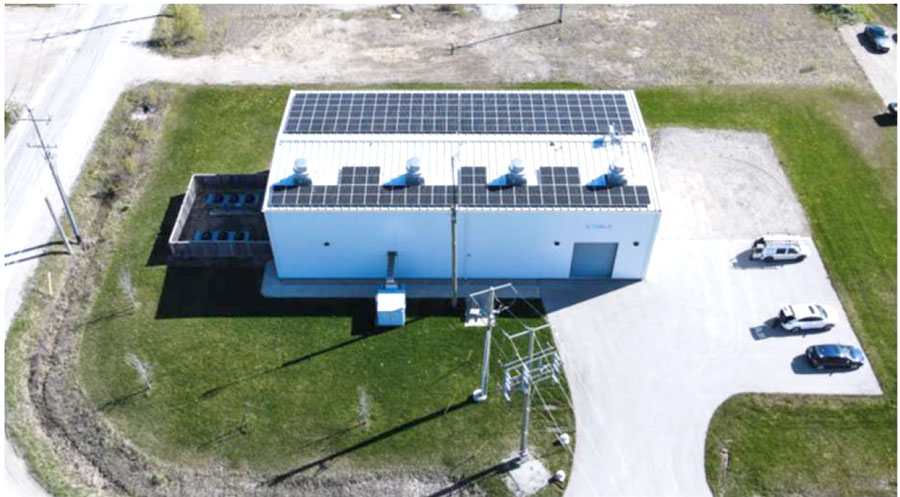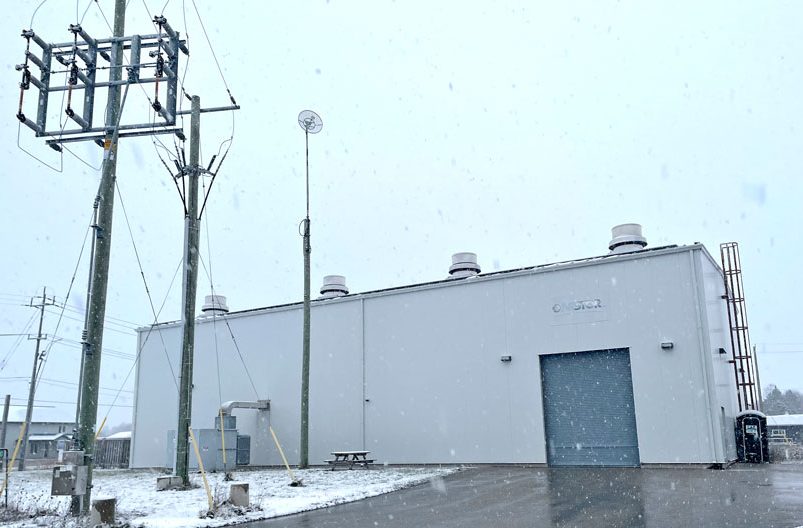MINTO – A company planning to redevelop an energy storage facility in the Harriston Industrial Park is seeking a motion of support from Minto town council.
At the Nov. 21 council meeting, Toronto-based Nexus Renewables advised council of its plans to partner with NRStor to turn that company’s Harriston energy storage facility into a battery energy storage system (BESS).
The systems are rechargeable batteries that store energy from various sources during off-peak hours and load onto the electricity grid when needed.
NRStor owns a two-megawatt flywheel energy storage and solar generation facility on a one-acre lot in the Harriston Industrial Park.
The facility was the first grid-connected commercial flywheel facility in Canada when it opened in 2014.
In 2021, council passed a resolution of support for plans by NRStor Inc. for storage capacity using lithium battery technology in order to bid on a contract with the Independent Electricity System Operator (IESO) to supply additional power to the grid.
Andrew Lin of Nexus Energy told councillors the current proposal was similar to the one they approved in 2021.
“We are proposing to renovate or to refurbish the facility that NSTor has that is currently a flywheel facility which retains energy and we’re proposing to replace it with a what’s called a BESS, or battery energy storage system,” said Lin.
In a presentation to council, Nexus officials explained NRStor’s contract with the IESO for the Harriston facility expired early in 2023 and the switch to battery energy storage fits with current IESO requirements for longer-term energy generation.
Nexus CEO Keith Sandor explained the flywheel system provides energy in 15-minute bursts.
“The province has kind of moved over towards more longer-term generation, which is generally something that can service at least four hours of need,” said Sandor.
He pointed out the Harriston energy storage facility has already pre-qualified with IESO to host a battery energy storage system.
Sandor said the Harriston facility would be a 10-megawatt operation.
“Because this is an existing facility, because it’s already been connected to the utility, because it’s actually … sized relatively small, the permitting process, the actual construction, the utility review, is less intensive and it’s something that can take place in a much shorter timeframe than some of these larger facilities that you may have heard of. They’re 100-plus megawatts. They take a long time to build,” he told council.
Sandor said construction on the project would take about 12 to 18 months, with an additional 12 months for the permitting process.
The IESO is attempting to fill a need for about 4,000 megawatts of new energy.
“That’s fairly sizable. It’s actually greater than the size of Pickering generating station or Darlington, or Bruce Power those big nuclear facilities,” Sandor noted.
Nexus plans to submit an application to fill a portion of that need when an RFP process opens in mid-December.
“We wanted to reach out to yourself to see if there’s support for this and field any questions,” explained Sandor.
Councillor Geoff Gunson asked about the potential fire risks at a facility of this nature.
“If fire happens to break. What’s the protocol? … I’ve read in the newspaper they could last 24 hours these fires … Is that something you’ve seen?” he asked.
“In New York I think they had a fire … and yes, these runway fires, they do extend for prolonged periods of time. When we design our batteries, we actually adhere to the most stringent codes across North America, it actually comes from New York City, so a lot of the other states and provinces in across North America are modelling their fire protection programs based off of New York standards,” Sandor replied.
Sandor added that the system design includes fire suppression technology.
“It’s a gas-based fire suppression. There’s a lot of education that goes on to the fire department as well, to make sure that they’re well informed on how to treat it if something does go wrong,” he said.
“There’s also, I think, wireless feeds that actually will automatically contact the fire department upon smoke or whatnot. So there is plenty of protection that’s involved.”

Aerial view of Harriston energy storage facility. Nexus Renewables image
Councillor Ed Podniewicz asked about the lifespan of the batteries and plans for recycling.
Sandor said the company aims for a 20-year lifespan for the batteries and leasing and financing agreements require them to post a decommissioning bond.
“So that at the end of that life we’re not just walking away and all of a sudden there’s this radioactive waste that’s lingering around,” said Sandor.
He added the company takes “a prudent approach” to ensure “the site is restored to its original state on decommissioning.”
The Nexus plan calls for batteries to be housed in about a dozen seacans outside the existing building.
Mayor Dave Turton asked about plans for the building that currently houses the flywheel setup.
Sandor said the flywheel will be removed and Nexus will attempt to find a new user for it.
“Currently, our understanding is that the technology is still utilized in some areas in the Caribbean,” he noted.
“And we’re looking just really for an off-taker, just because the technology is still in good shape.”
The building itself, he said, could possibly be used as a testing site for new equipment, or potentially as housing for a larger battery system to accommodate a future IESO RFP.
Sandor said the company is planning to run a virtual public meeting to get community feedback on the project.
“We’ve reached out to a lot of the neighbouring landowners, just to advise them … this is something that we’re thinking of, any feedback would be greatly appreciated,” he said.
Council passed a motion to accept the delegation and directed staff to bring back a report to the Dec. 5 meeting.
At that point, council will consider providing Nexus with a motion in support of its application.
The deadline for the IESO RFP is Dec. 12.




